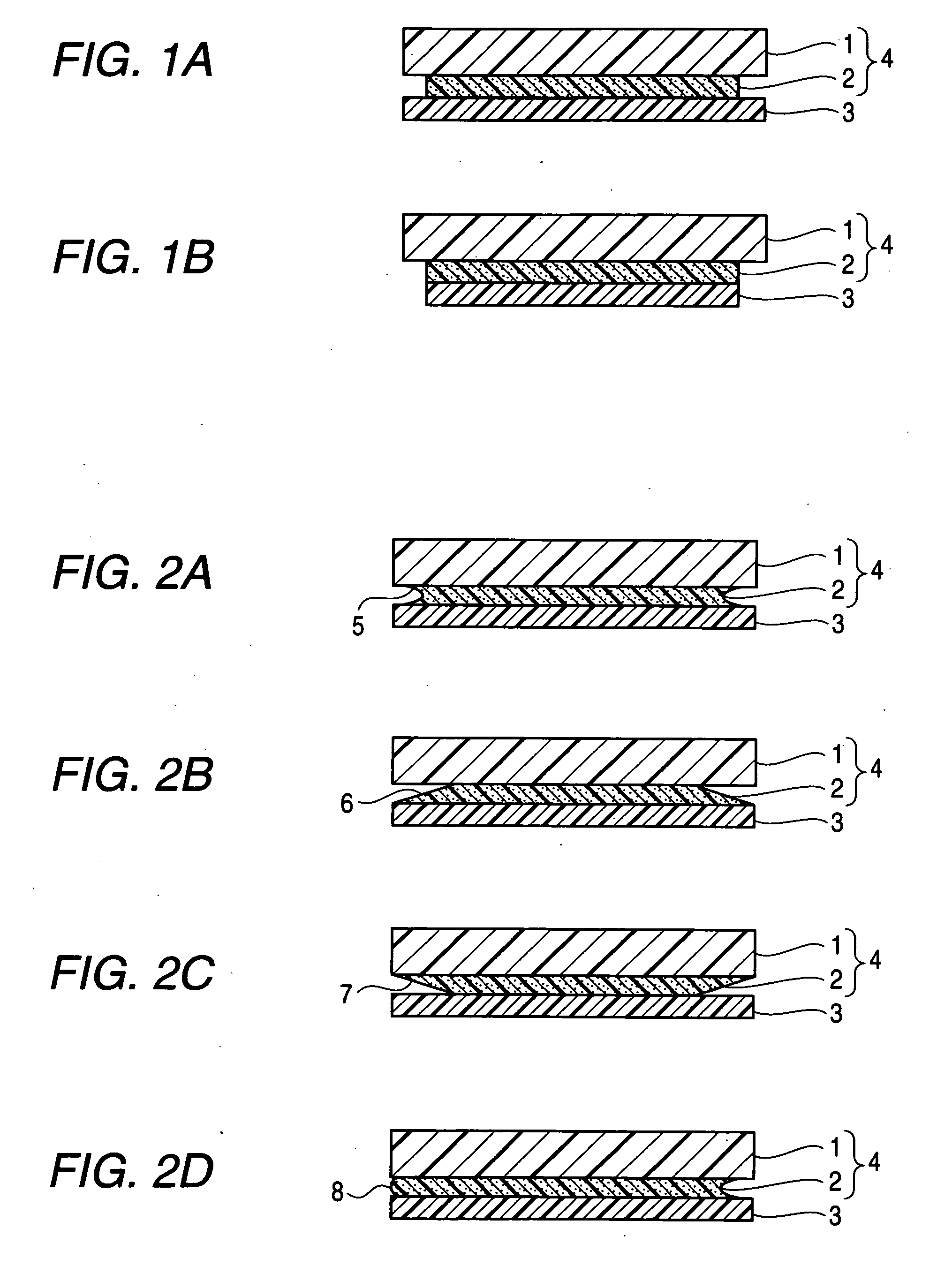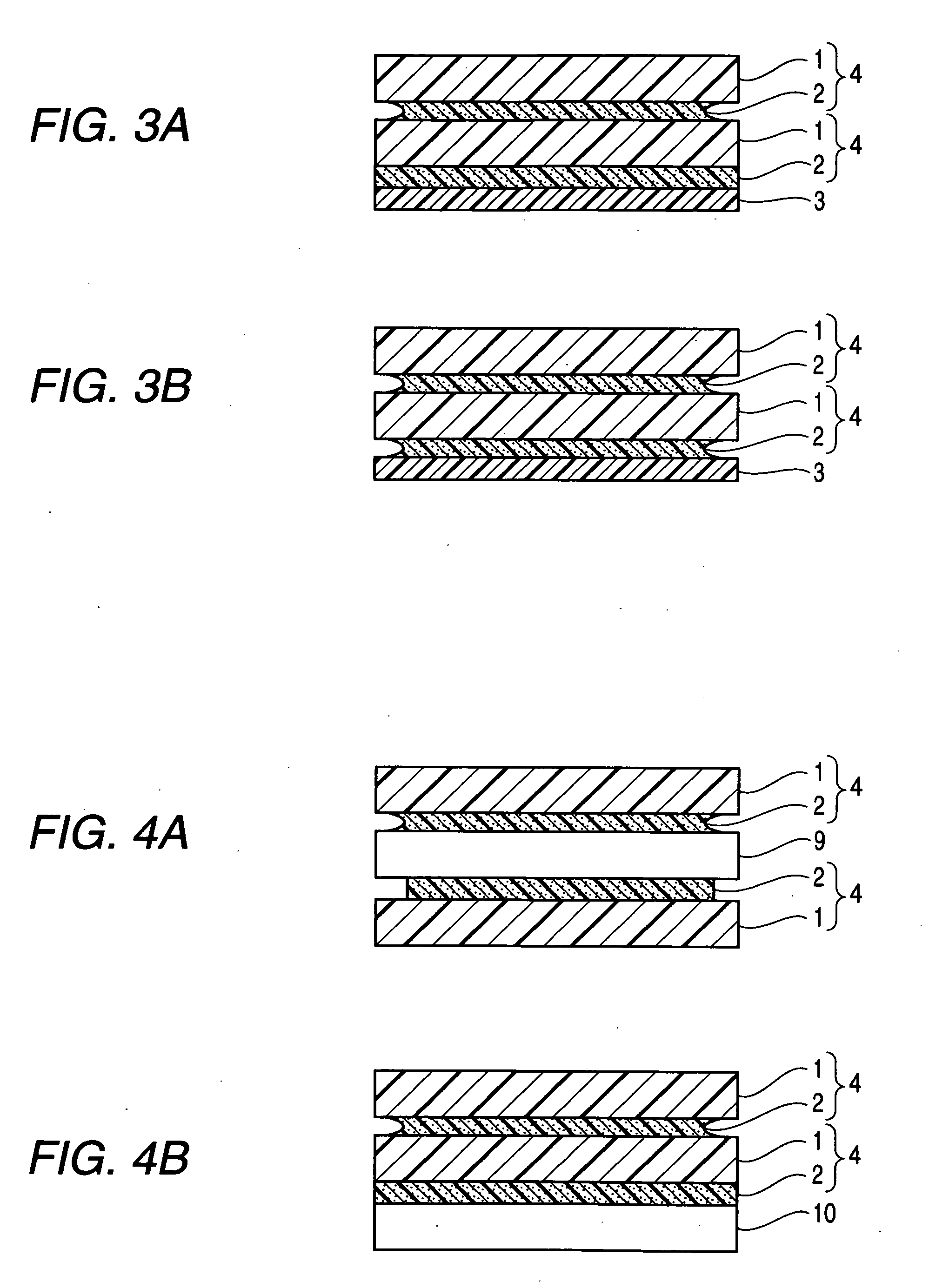Adhesive optical film, method for manufacturing adhesive optical film and image display
a technology of adhesive optical film and adhesive adhesive, which is applied in the direction of film/foil adhesive, polarising elements, synthetic resin layered products, etc., can solve the problems of defective display, defective display, dropped adhesive, etc., and achieve the effect of obtaining more easily and more simply
- Summary
- Abstract
- Description
- Claims
- Application Information
AI Technical Summary
Benefits of technology
Problems solved by technology
Method used
Image
Examples
example 1
(Preparation of Acrylic Polymer)
[0101] In a separable flask equipped with a thermometer, a stirrer, a reflux condenser and a nitrogen-gas introduction tube, 97 parts of butyl acrylate, 3 parts of acrylic acid, 0.2 parts of azobisisobutyronitrile and ethyl acetate in an amount required for adjusting the solid contents to 30% were set, and then nitrogen replacement was carried out for about 1 hour while admitting nitrogen gas into the flask and stirring the ingredients put in the flask. Thereafter, reaction was run for 7 hours while heating the flask at 60° C. to yield an acrylic polymer having a weight average molecular weight (Mw) of 1,000,000.
(Preparation of Adhesive Composition)
[0102] An adhesive composition (in solution form) was prepared by admixing the acrylic polymer prepared in the foregoing manner (100 parts on a solids basis) with 10 parts of butyl acrylate (BA) oligomer (Mw=3,000), 0.8 parts of trimethylolpropane tolylenediisocyanate as a cross-linking agent of isocya...
example 2
[0104] An adhesive-type polarizing plate was made by laminating, on the polarizing plate stamped into the size of 11 inches by means of a Thomson blade as used in Example 1 (for making another adhesive-type optical film), an adhesive-applied release film made by applying a coating of the same adhesive solution as prepared in Example 1 to a 38 μm-thick release film of polyethylene terephthalate-based so as to cover the entire area of 11-inch size and have a dry thickness of 25 μm and then drying the coating at 100° C. for 4 minutes to form an adhesive layer (loss elasticity modulus: 8.0×104 Pa (25° C.)). Fifty sheets of the thus made adhesive-type polarizing plate were stacked on top of each other, and pinched at the top and the bottom with a jig shaped like a vise while controlling pressure so that the adhesive extruded from the edges. In just the pressurized state they were, the adhesive layers were cut together with the optical films at the position 1.0 mm away in an inward direct...
example 3
[0105] An adhesive-type polarizing plate was made by laminating, on the polarizing plate stamped into the size of 11 inches by means of a Thomson blade as used in Example 1 (for making another adhesive-type optical film), an adhesive-applied release film made by applying a coating of the same adhesive solution as prepared in Example 1 to a 38 μm-thick release film of polyethylene terephthalate-based so as to cover the entire area of 11-inch size and have a dry thickness of 40 μm and then drying the coating at 100° C. for 4 minutes to form an adhesive layer (loss elasticity modulus: 1.1×103 Pa (25° C.)). Fifty sheets of the thus made adhesive-type polarizing plate were stacked on top of each other, and pinched at the top and the bottom with a jig shaped like a vise while controlling pressure so that the adhesive extruded from the edges. In just the pressurized state they were, the adhesive extruded out of the optical film edges was cut away with a rotary blade. Thereafter, the stacke...
PUM
| Property | Measurement | Unit |
|---|---|---|
| distance | aaaaa | aaaaa |
| storage modulus | aaaaa | aaaaa |
| temperature | aaaaa | aaaaa |
Abstract
Description
Claims
Application Information
 Login to View More
Login to View More - R&D
- Intellectual Property
- Life Sciences
- Materials
- Tech Scout
- Unparalleled Data Quality
- Higher Quality Content
- 60% Fewer Hallucinations
Browse by: Latest US Patents, China's latest patents, Technical Efficacy Thesaurus, Application Domain, Technology Topic, Popular Technical Reports.
© 2025 PatSnap. All rights reserved.Legal|Privacy policy|Modern Slavery Act Transparency Statement|Sitemap|About US| Contact US: help@patsnap.com



